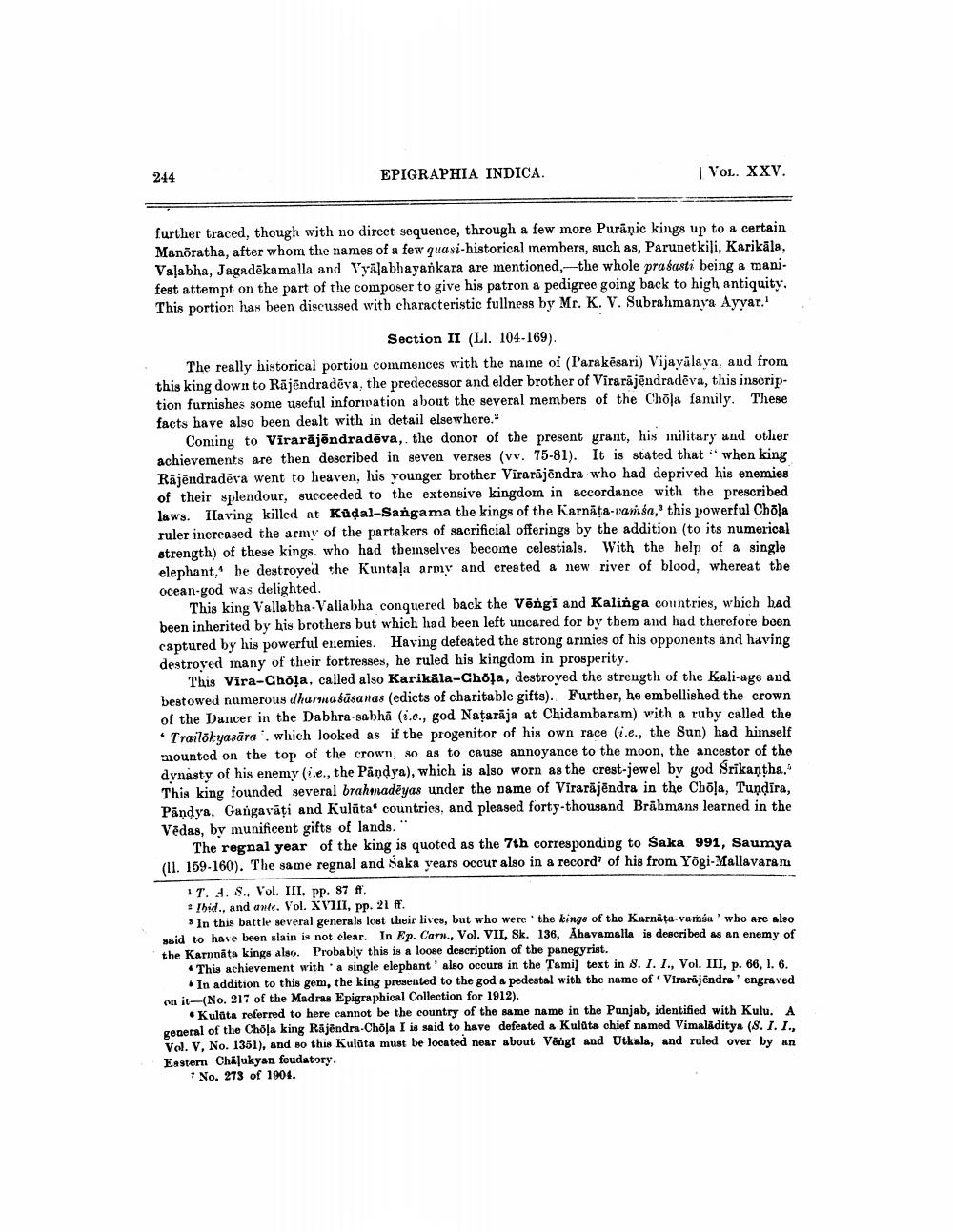________________
244
EPIGRAPHIA INDICA.
Vol. XXV.
further traced, though with no direct sequence, through a few more Puranic kings up to a certain Manöratha, after whom the names of a few quasi-historical members, such as, Parunetkisi, Karikāla, Valabha, Jagadēkamalla and Vyalabhayankara are mentioned, -the whole prasasti being a manifest attempt on the part of the composer to give his patron a pedigree going back to high antiquity. This portion has been discussed with characteristic fullness by Mr. K. V. Subrahmanya Ayvar.!
Section II (LI. 104-169). The really historical portion commences with the name of (Parakēsari) Vijayālava, and from this king down to Rājēndradova, the predecessor and elder brother of Virarājēndradēva, this inscription furnishes some useful information about the several members of the Chola family. These facts have also been dealt with in detail elsewhere.
Coming to Virarājēndradēva, the donor of the present grant, his military and other achievements are then described in seven verses (vv. 75-81). It is stated that when king Rājēndradeva went to heaven, his younger brother Virarājēndra who had deprived his enemies of their splendour, succeeded to the extensive kingdom in accordance with the prescribed laws. Having killed at Kudal-Sangama the kings of the Karnāta-ramấn, this powerful Chola ruler increased the army of the partakers of sacrificial offerings by the addition (to its numerical strength) of these kings, who had themselves become celestials. With the help of a single elephant, be destroyed the Kuntaļa army and created a new river of blood, whereat the ocean-god was delighted
This king Vallabha-Vallabha conquered back the Võngi and Kalinga countries, which had been inherited by his brothers but which had been left uncared for by them and had therefore boen captured by his powerful enemies. Having defeated the strong armies of his opponents and having destroyed many of their fortresses, he ruled his kingdom in prosperity.
This Vira-Choļa, called also Karikäla-Chöļa, destroyed the strength of the Kali-age and bestowed numerous dharmaśāsanas (edicts of charitable gifts). Further, he embellished the crown of the Dancer in the Dabhra-sabha (i.e., god Natarāja at Chidambaram) with a ruby called the
Trailokyasārawhich looked as if the progenitor of his own race (i.e., the Sun) had himself mounted on the top of the crown. so as to cause annoyance to the moon, the ancestor of the dynasty of his enemy (i.e., the Pandya), which is also worn as the crest-jewel by god Srikantha. This king founded several brahmaděyas under the name of Virarajendra in the Chola, Tundira, Påndya, Gangavāți and Kulūtas countries, and pleased forty-thousand Brāhmans learned in the Vēdas, by munificent gifts of lands."
The regnal year of the king is quoted as the 7th corresponding to Saka 991, Saumya (11. 159-160). The same regnal and Saka years occur also in a record of his from Yögi-Mallavaranı
IT. J. S.. Vol. III, pp. 87 f.
Thid., and ante. Vol. XVIII, pp. 21 ff.
In this battle several generals lost their lives, but who were the kings of the Karnāta-vamsa' who are also said to have been slain is not clear. In Ep. Carn., Vol. VII, Sk. 136, Ahavamalla is described as an enemy of the Karnnāta kings also. Probably this is a loose description of the panegyrist.
• This achievement with a single elephant' also occurs in the Tamil text in 8. 1. I., Vol. III, p. 66, 1. 6.
In addition to this gem, the king presented to the god & pedestal with the name of Virarijëndra engraved on it-(No. 217 of the Madras Epigraphical Collection for 1912).
• Kulata referred to here cannot be the country of the same name in the Punjab, identified with Kulu. A general of the Chola king Rājēndra-Chola I is said to have defeated a Kulata chief named Vimaliditya (8. I. I.. Vol. V, No. 1361), and so this Kulata must be located near about Vang! and Utkala, and ruled over by an Eastern Chalukyan feudatory.
No. 273 of 1904.




